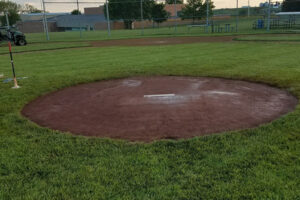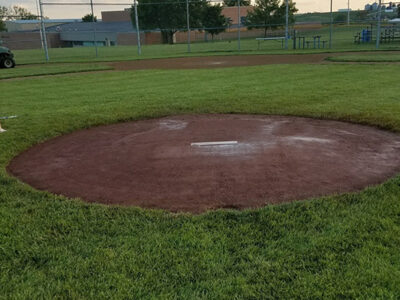Picture this:
- A sunny afternoon
- A well-maintained backyard
- A group of friends ready for an epic baseball showdown
All this could not have been possible without the pitching mound. It’s not just a patch of dirt; it’s a canvas for the science of precision.
Here, we’ll discuss the nitty-gritty of creating the ideal backyard pitching mound slope, unlocking the secrets behind a game-ready backyard.
Backyard Pitching Mound 101
Let’s understand the fundamentals before diving into the perfect slope’s science. A pitching mound is more than a raised mound of dirt; it’s a carefully crafted surface designed to enhance a pitcher’s performance.
The mound’s primary role is to give the pitcher an advantage, allowing them to control their pitches effectively. When constructing your pitching mound, consider these key elements:
Elevation Matters | Backyard Pitching Mound
- A proper elevation gives the pitcher a mechanical advantage.
- Elevate the pitcher’s plate to transition seamlessly from the flat ground to the mound.
Size and Shape
- Ensure the mound adheres to regulation size and shape specifications.
- The pitcher’s plate should be at the center of the mound, forming a symmetrical and balanced surface.
Decoding the Science of Pitching Mound Slope
Now, let’s unravel the mystery behind the perfect pitching mound slope. This isn’t just about aesthetics; it’s about physics and biomechanics working harmoniously to give the pitcher the upper hand.
Finding the Sweet Spot
Creating the ideal slope involves understanding the angles that optimize a pitcher’s performance. This is where the pitching mound slope specifications come into play.
- The backyard pitching mound’s slope is the hero of a pitcher’s game.
- A subtle yet crucial part of pitching mound construction is adhering to specific slope specifications.
The Rule of Thumb: The 1:1 Ratio
Achieving the right balance is crucial. The 1:1 ratio is a golden rule for crafting the perfect pitching mound.
- Aim for a slope that rises one inch for every foot from the front of the pitcher’s plate to the pitching rubber.
- This ratio optimizes the pitcher’s stride and enhances pitch control.
Crafting the Mound with Precision
It’s not just about the numbers; it’s about translating them into a tangible, game-ready surface.
- When building your mound, pay close attention to pitching mound slope specifications.
- Use a level and measuring tape to ensure precision in implementing the specified slope.
- Create a gradual rise from the front to the center of the mound.
- Compact the soil to prevent uneven settling, maintaining the slope over time.
Tips for Backyard Pitching Perfection
Now that you’ve grasped the science let’s explore some practical tips to fine-tune your pitching mound.
Blend the Mound with Your Yard
- Ensure the mound’s integration into your yard is seamless for aesthetic appeal and practicality.
- Use native soil or quality clay to match your yard’s composition.
Preserve the Perfect Slope | Backyard Pitching Mound
- Regularly inspect and maintain the slope to prevent erosion or settling.
- Refurbish the surface with clay or soil to maintain the optimal slope.
Pitcher’s Plate Precision
- Anchor the pitcher’s plate securely for a stable foundation.
- Check the plate’s alignment regularly to maintain accuracy.
Bringing the Backyard Pitching Mound to Life
In your quest for the perfect backyard pitching mound, remember, it’s not just a mound; it’s a science. From understanding the nuances of slope specifications to the practical art of construction, every element plays a role. So, roll up your sleeves, get your hands dirty, and transform your backyard into a pitcher’s paradise—one perfectly sloped mound at a time.
At Victory Mounds, we pride ourselves on delivering premium baseball and softball products and services. From meticulously crafted pitching mounds to top-notch equipment, we elevate your game with quality and precision. Choose Victory Mounds for an unparalleled experience on the field. Contact us today!


